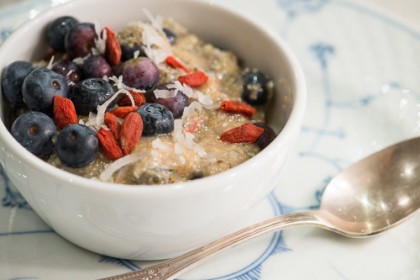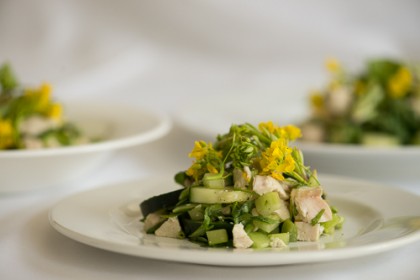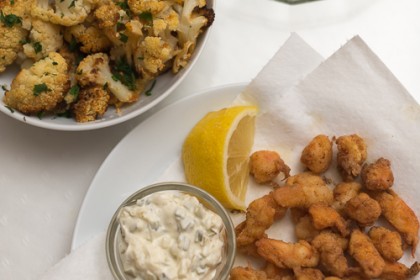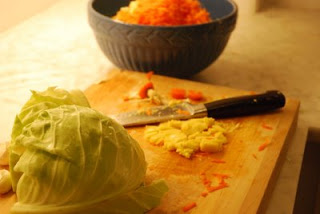Cultured Veggies
from The Body Ecology Diet by Donna Gates
Use organic clean veggies. After washing the veggies, spin them dry. Clean equipment is essential. Scald everything you use in very hot water.
1 head cabbage, shredded in a food processor or by hand-reserve 2 whole leaves
2 carrots, shredded in a food processor or by hand
1 inch piece of ginger, peeled and chopped
2 cloves garlic, peeled and chopped<--I would leave this out! To Make Cultured Vegetables: 1. combine all ingredients in a large bowl. 2. remove several cups of mixture and put into a blender. 3. add enough filtered water to make a "brine" the consistency of a thick juice. Blend well and then add brine back into first mixture. Stir well. 4. Pack mixture down into a glass or stainless steel, air tight container. Use your fist or a wooden dowel or a potato masher to pack veggies tightly. 5. Fill container almost full, but leave about 2 inches of room at the top for veggies to expand. 6. Roll up several cabbage leaves into a tight "log" and place them on top to fill the remaining 2 inches of space. Clamp jar closed. 7. let veggies sit at about a 70 degree room temperature for at least 3 days. A week is even better. Refrigerate to slow down fermentation. Enjoy 1/2 cup or more per day.





Pink Dogwood - I know the Nourishing Traditions cookbook adds whey to the mix to help ferment. Did you add this? You are the second person to say less than glowing things about fermented veggies – hmmm, starting to wonder if I should bother?! I look forward to hearing other comments…
I look forward to hearing other comments…
Our Family Is His - Hmm, doesn’t really sound like anything I would be brave enough to try. However, my 3 year old would probably eat it up. He’s icky like that. He would eat oranges dipped in ketchup all day long if I let him. He’s pretty much a vegetarian (has been since his first bite of real food, just doesn’t like any proteins – meat especially). I might just have to try it and see.
Anonymous - Yes – the veggies are very tart and we are used to tastes on the other side of the spectrum. Also, yes – they do smell, especially when initially opened. I was banned from eating them at work — unless I went outside.
Also, making cultured veggies is a continuous experimentation process. The first batch is never right. You’ll find you like different seasonings better than others or different veggies more than others. Consistency also affects the overall experience — you can go for the mushy veggies or chunky. For example, I don’t like carrots in my veggies, but I like a version with red cabbage, celery, sweet potato, cilantro, red bell peppers — or another good one is green cabbage, daikon, cucumber, celery, ginger and caraway seeds.
I find that they are less tart at room temperature — so in the AM, I pull out a portion from the fridge to leave on the counter. Can’t really do this when it’s 90 degrees, however.
You can also ‘hide’ the taste of them in sandwiches (but of course a gluten free bread) or in a ‘chop’ salad. They are great with Flax crackers and also better salted (organic seat salt, of course) and seasoned – if you wish. Try adding olive oil or pumpkin oil – hhmmmm.
I urge all to experiment with recipes. Try making a version that can be sweetened: Green cabbage with cinnamon!! Then you add a no-Glycemic index sweetener like Donna Gate’s Lakanto or stevia. If dairy is not a problem, then add raw cultured milk kefir and it’s apple pie ala Mode.
You can order veggies online to be shipped to experience different tastes. I know that http://www.healingmovement.net in Santa Monica, CA does ship, for example.
Seriously, ingesting these probiotics via food or beverage is the sure way to get them into your gut to repopulate. Often when taken as a supplement they are killed by stomach acid.
I’m still healing, but the cultured foods regularly, while eliminating sugar, flour and dairy (for the most part) has helped tremendously and I’ve seen others make vast improvements.
Happy culturing — you’re on the right track — Just follow your gut 😉
Cannon and Kassie - I love the saurkraut that I buy from my farmer and we eat it anytime we eat meat…not 1/2 cup a day, I don’t think I could manage : ) But a few tablespoons is great with the meal. I’m not sure how he makes it but it says it has cabbage water and sea salt in it. I would love to get a food processor so i can make my own though.
Anonymous - fyi — not good to add sea salt before the fermentation process. Sea salt slows down the bacterial growth, lowering counts of lactobacillicus. You can add sea salt once they’ve cultured, as well as salad dressings and oils.